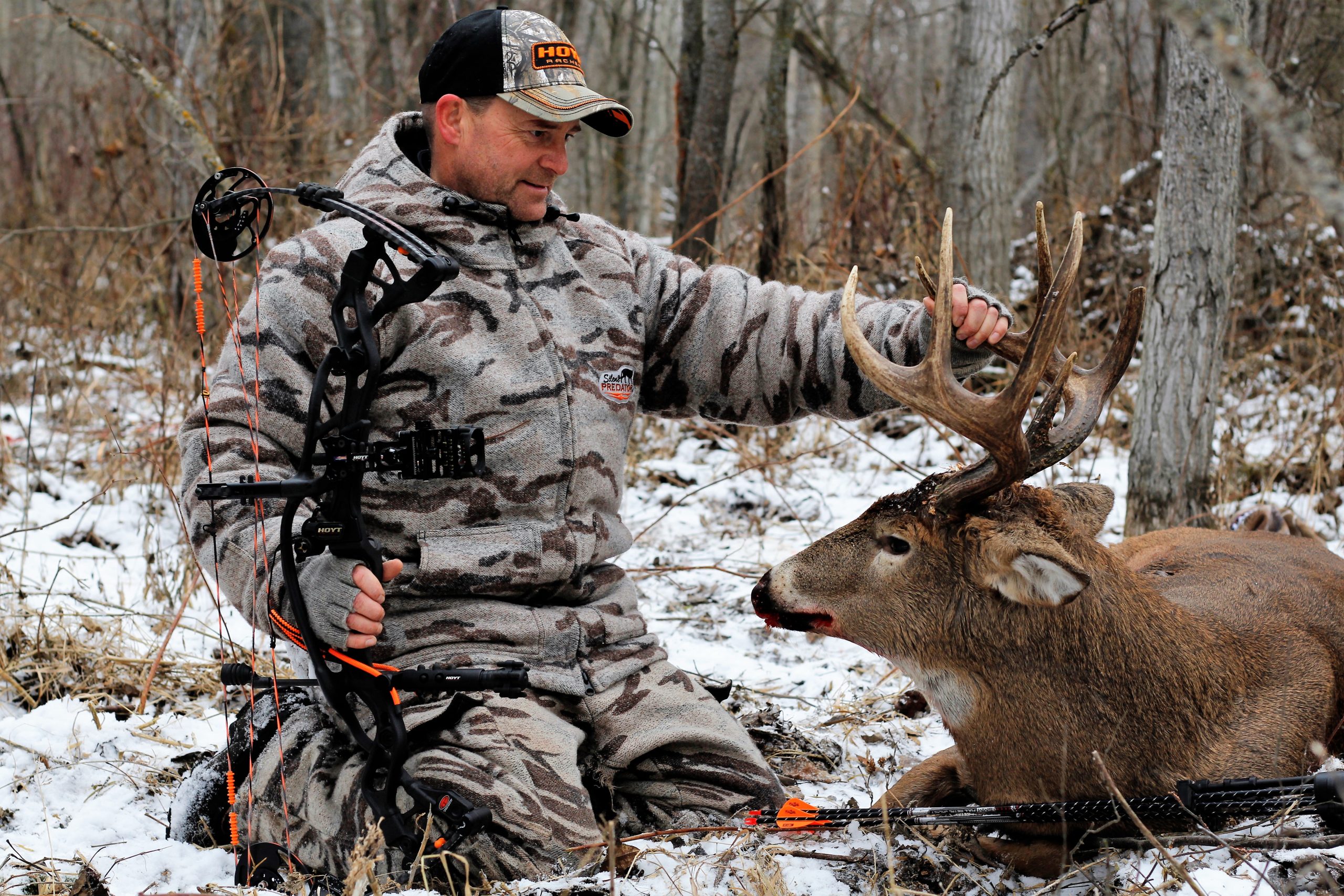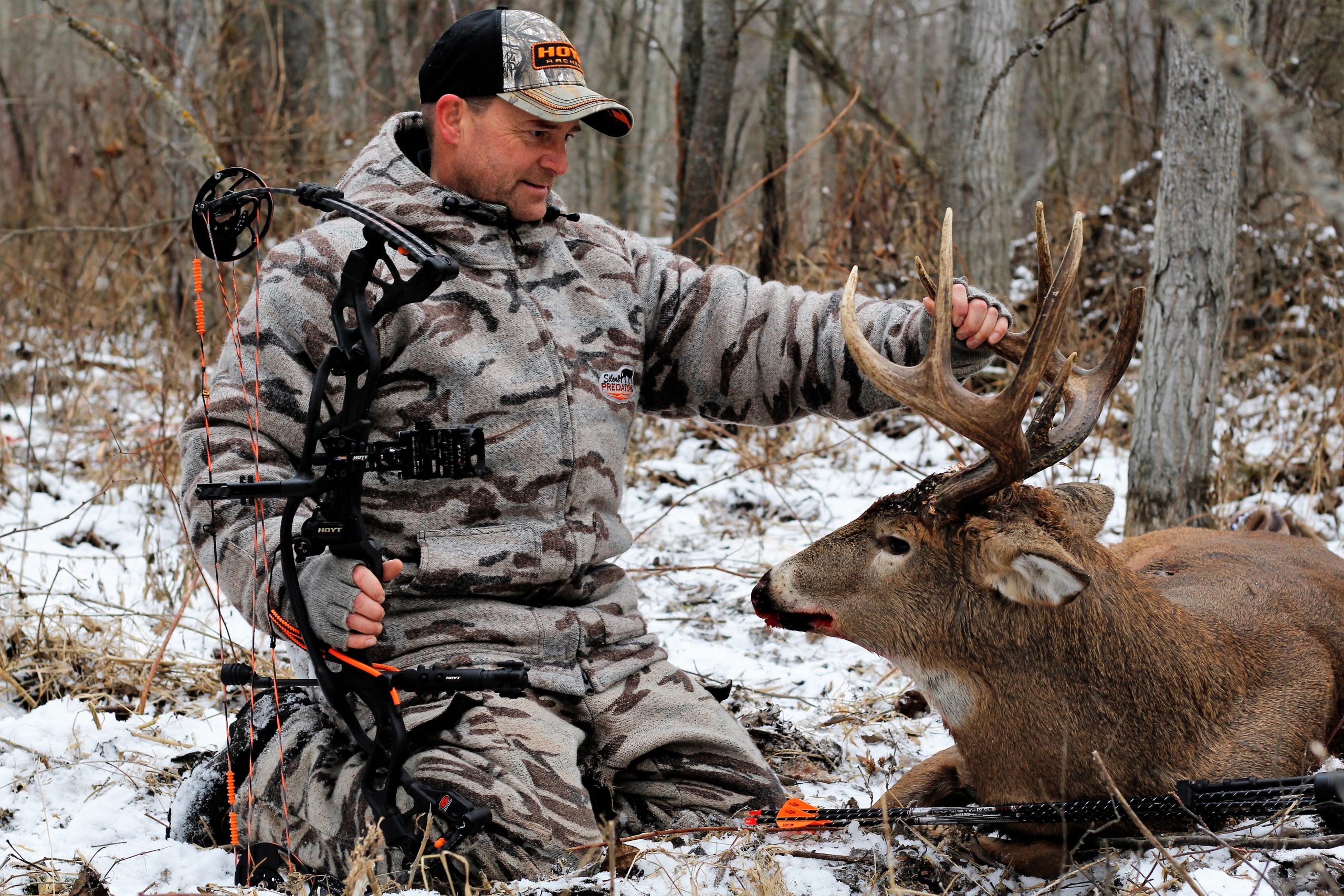As bowhunters, we capitalize on a lot of different things to bring deer in close. With the goal of fooling their nose, ears and eyes, here are a few tools and strategies to employ as you work to fill your next whitetail tag.
Scent Matters
We’ll leave the topic of scent control for another post, but when it comes to communication, attractants can play a big part in our success in the deer woods. Generally, these include doe estrus urine (where allowed by law) or synthetic similes. I’ve experimented with many manufacturers over the years, and one that I consistently see great success with is Tink’s products. The key to using attractants is moderation. I’ve seen hunters set up a virtual perfume parlor in their hunting area. Let me assure you, for the most part, this doesn’t work. On the other hand, routinely anointing primary scrapes with a few drops of doe estrus scent and even dominant buck scent, can do wonders for holding bucks in the area and encouraging them to visit those scrapes more frequently. By servicing these scrapes, you send the message that there is a doe in heat in the area, or a dominant buck moving in on the resident does. If you really want to lay down the gauntlet, make and service a mock scrape proximal to a natural scrape. Put a few drops of the Tink’s estrus scent or spray Wildlife Research Center’s Synthetic Estrus Scent in the natural and/or mock scrapes, and this too sends a message. Bucks in the area will smell it, and not only revisit the scrapes, but eventually service your mock scrape themselves.

Rattling to Draw Them In
Rattling involves working two relatively fresh shed antlers, or synthetic alternatives, together to emulate the sound of two bucks fighting. This strategy often draws bucks in, especially in areas with a higher buck-to-doe ratio. Rattle in areas with a good age-class structure, from late October to the end of November (even December and early January in some southern jurisdictions), and your chances for success go way up. At this time, bucks are primed and eager to either come in for a look, or to fight to defend breeding rights. Especially effective during the pre-rut and on through the first estrus, but, as soon as the lockdown phase of the rut hits, it typically becomes less productive overall.
With a good set of antlers (or rattling bag or synthetic antlers) in hand, learning how to rattle is easy. Just remember two things. First, the goal is to mimic a natural confrontation. And second, the moment those two antlers come together, anything can happen. Authenticity is the name of the game. For me, an increasingly aggressive sequence usually outperforms the haphazard approach. As you begin, imagine you are two bucks sizing each other up. Unfamiliar bucks first posture, then slowly approach. Initial contact is cautious, sliding their racks together to evaluate each other. They often do this for up to a minute and then separate, followed by up to a five-minute break, during which time each postures, grunts, rakes branches, urinates and circles the other. When they come together again, it is more aggressive. Remember, simply bashing bone on bone isn’t realistic. A natural confrontation involves twisting and grinding, with periodic clatter. This should last for up to a minute. Then, following that deliberate physical confrontation, separate. Then, about 10-minutes later, commence with a third and final round. Now emulate an all-out antler-splitting brawl. After a full minute of louder rattling, again separate with a clean break. Add a few grunt calls and doe bleats to this show and you become almost irresistible to a whitetail buck at this time of the season.

Calls Entice
Vocalizations most relevant for hunters are the buck grunt, snort wheeze and doe bleat. Deer, like other ungulates, become more vocal and vulnerable throughout the various stages of the rut. Their instinct to find breeding partners kicks this heightened communication into gear.
Aggressive bucks hearing the grunt of another buck, may respond to confront the intruder. In comparison, a buck may also respond favorably to a doe bleat in hopes of a chance to breed. Both are typical scenarios that we can use to entice a buck. As a rule, buck grunts are very effective up until the first estrus, becoming less effective and even repelling bucks after that. Then, for a short few-day window when whitetails go through their second estrus approximately 10-14 days after the first round, these vocalizations can again become very effective in communicating with, and enticing a buck into shooting range. The snort wheeze is essentially a challenge sound. If a buck is nearby, but perhaps reluctant to commit to your other vocalizations, consider using a snort wheeze to kick him into gear. This combination is aggressive and basically throws down a challenge to an incoming buck, saying “I’m here, come and get me.” It can be especially effective during the peak estrus windows.

Decoys Can Be Good or Bad
Visual cues too, can be great for communicating with whitetails – but not always. During the pre-rut a buck decoy can attract another buck for a confrontation. From late October on into early November, decoys can be almost irresistible. A doe decoy can work well throughout the season, but especially in the pre-rut and peak rut. After the first estrus, doe decoys can be hit and miss, but work well again during the second estrus. A buck decoy, on the other hand, can literally repel other bucks after the first estrus. While there are always exceptions, after the does go into heat, a buck’s focus is more on breeding, and traveling to find ready does, than engaging in a confrontation. Regardless of which decoy you use when, or if you use a buck and doe decoy together, the key is to place them in a highly visible location. Whitetails don’t like surprises, so they prefer to be able to see and evaluate the decoy initially from a distance. Using them in tight quarters can sometimes backfire, sending a buck on his way in a hurry, particularly if they are surprised by its sudden appearance.
All told, communicating with whitetails is about appealing to their senses, taking steps to convince them of your authenticity, and drawing them in close for a shot opportunity. Fooling their nose, ears and eyes is what it’s all about.




All excellent suggestions!
Been hunting/studying whitetails for over 50 years and live in a deer rich area (15 passed thru my front yard this morning, and 6 more as I’m texting) for the last 18 years.
The local deer are wild but trust me (I don’t hunt them anymore). Some will keep a 30 foot flight distance, others are comfortable at arms length so I get to observe them closely.
I interact with deer on a daily basis and just wanted to mention that they are individuals so don’t presume that all deer will react the same way. Some are shy, others bold; or skittish/confident; or submissive/dominant – there’s even pranksters and jokers in the mix.
There was a buck fawn who would give a false alarm (snort and high tail) to spook all the other deer then run to me to grab the apples for himself 🙂 Saw him recently, at 4 yo he’s pushing 275 pounds and has heavy 10 point rack. He visits every rut to be with the does but still comes to 20-25 feet when I call him. Nice to see!
It helps that I understand the deer’s verbal and body language to know how to handle the situation. I recommend watching/analyzing videos to learn the body language, that knowledge can pay big dividends when hunting.
Cheers!
Vana2, sounds like you should be making the videos with your own explanations of your interpretation of the body language. Speaking of language, recordings of deer vocalizations would be awesome, too.
Roamin,
It’s pretty easy to interpret the body language from any of the deer videos. Look at the situation and see what the deer is doing.
Find a video where the deer are not aware of the photographer, the deer will be feeding, look up regularly and calmly check the area for danger; if all is good, the tail will give a little flick signaling to all the deer in the area “all clear”.
If the deer becomes aware of the photographer, it will focus ears and eyes on the danger in an alert stance. The angle of the tail shows the level of concern… Down and still is concerned; 45 is nervous; horizontal is very nervous, and vertical afraid. Deer will often tuck their ears back just before they bolt. A nervous deer will show signs of agitation – jerky movements, looking up frequently, bobbing the head around to get a better visual fix on something.
If the deer sees something they don’t recognize but are not alarmed yet, they will often stomp to warn the other deer in the group.
Deer, unless badly scared, have a short attention span and will usually return to what they were doing after a couple of minutes. I’ve given the “all clear” signal and had nervous deer calm down immediately – but then they do know me.
Deer are curious and will come over to investigate sounds and activities. I have used a radio (tuned off station to a quiet hiss), to attract and distract deer for an easy shot. It’s a sneaky trick.
Deer are fun to interact with.
A couple of years ago I was working at the side of the house with a doe (Molly) feeding near by. She suddenly went to full alert and stomped warning me of danger. I walked over to her and put my hand on her shoulder to calm her. There was a (very confused) guy standing in the driveway taking pictures of the “wild” deer I was now standing beside. He walked away shaking his head LOL!
Another time I was gardening with a bunch of deer feeding all around me. A dog was loose (illegally) and started coming our way. I gave an alarm snort, the deer took off in every direction – and I chased the dog away with a rake. Nice to be accepted as part of the group.
Cheers!
“If the deer becomes aware of the photographer, it will focus ears and eyes on the danger in an alert stance….”
How right you are. This guy was visiting my neighbor’s yard recently while I was outside grilling. If I see him after Thanksgiving, I’ll be grilling venison.
He’s a real beauty Roamin!
Nice to see a mature buck with a symmetrical rack like that. …But I prefer a young doe for eating and would let him walk away.
Yeah, he has his eye on you but is not overly concerned.
Thanks for sharing the picture!
Hank